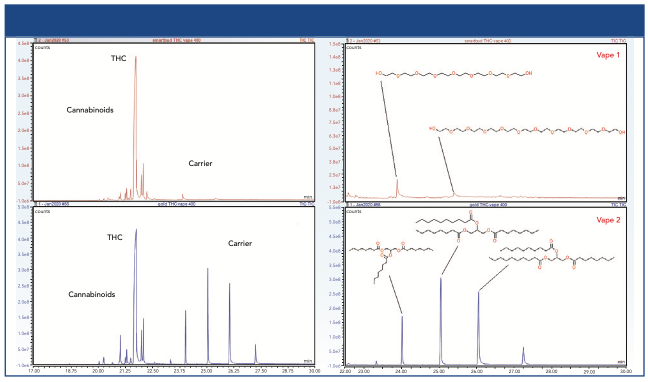CDS Analytical - Analysis of Tetrahydrocannabinol Vape Oils Using Pyroprobe by Thermal Extraction
This application note demonstrates a multistep thermal extraction study on tetrahydrocannabinol (THC) vape oils.
E-cigarettes have gained popularity in recent years, in conjunction with the legalization of marijuana in many U.S. states. Authentic THC vape oils are not easily distinguishable from counterfeits, which are poorly regulated and can cause severe lung injuries. There has been a growing national interest in the effective analysis of THC vape oils. One of the challenges is that vape oil comes with a complex solvent and contains a variety of volatile and semivolatile ingredients. Before analysis via GC or HPLC, the sample needs to be either extracted or diluted before analysis, to avoid saturating the instrument. While these approaches may be adequate, they have limitations related to human error in wet chemistry and high cost through intensive labor. A direct thermal extraction of vape oils using a Pyroprobe can provide a fast and accurate solution.
Experimental Conditions
Each THC vape oil of 200 μg was thermally extracted using a multistep sequence by a CDS Analytical Model 6150 Pyroprobe with an autosampler module. The instrument was interfaced to a mainstream GC–MS instrument. A DISC tube was used as the sample vessel.
Pyroprobe:
Set points: 200 °C, 400 °C, 600 °C, 60 s
DISC Interface: 300 °C
Transfer Line: 300 °C
Valve Oven: 300 °C
GC-MS
Column: 5% phenyl (30 m × 0.25 mm)
Inlet: 360 °C
Carrier: Helium 1.25mL/min, 80:1 split
Oven: 40 °C for 2 min, 2 °C/min to 300 °C
Ion Source: 250 °C
Mass Range: 35–600 amu
Results
Figure 1 shows a THC vape oil extracted at three sequential temperatures, 200 °C, 400 °C, and then 600 °C. At 200 °C, THC vaporizes. At 400 °C, more THC, cannabinoids, and carrier agents are extracted, and at 600 °C, a trace of cannabinoids and carrier agents is detected.
Figure 1: Time and signal offset overlay of THC vape oil externally extracted at 200 °C(bottom), 400 °C (middle), and 600 °C (top).

From the multistep run, it was concluded that 400 °C was the optimized thermal extraction temperature. Figure 2 shows 400 °C runs on two different vape oils. The profiles for THC and other cannabinoids were quite similar (Figure 2, left). However, the carrier of these two vape oils differs (Figure 2, right). Vitamin E acetate, which is a known by the CDC to be added to illicit vapes, was not detected in either oil. Vape oil 1 contains a series of polyethylene glycols (PEG). PEG can create carcinogens like acetaldehyde and formaldehyde when heated to high temperatures.
Figure 2: Two THC vape oils at 400 °C (after 200°C), full chromatogram (left), and magnification (right).

Instead of PEG, vape oil 2 has a series of medium chain triglycerides (MCT), associated with coconut and palm kernel oils. While MCT oil is healthy to ingest, chronic vaping of this substance can cause lipid pneumonia, as oil coats the inside of the lungs preventing adequate oxygen exchange.
Conclusion
Multistep thermal extraction by Pyroprobe 6150 allows the analysis of volatile and semivolatiles directly to the gas chromatograph. Because there is no sample preparation step involved, thermal extraction can be an efficient way to analyze vape oil. Differences in semivolatile ingredients, specifically carriers, were found between two different THC vape oil brands.

CDS Analytical
465 Limestone Road, P.O. Box 277 Oxford, PA 19363-0277
tel: (610) 932-3636, (800) 541-6593
Website: www.cdsanalytical.com

MALDI Guided SpatialOMx® Uncovers Proteomic Profiles in Tumor Subpopulations of Breast Cancer
September 1st 2020The timsTOF fleX system bridges a current gap by providing MALDI Imaging and in-depth proteomics analysis in just one instrument. The instrument offers all benefits of a timsTOF Pro for time-efficient and sensitive proteomics, combined with a high-resolution MALDI source and stage. Using PASEF technology, it is possible to retrieve high protein ID rates with small sample amounts. Here we present the new SpatialOMx® workflow to identify distinct proteomic profiles for different tumor subpopulations in breast cancer as an example for this powerful approach.









